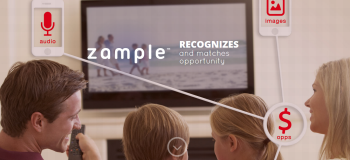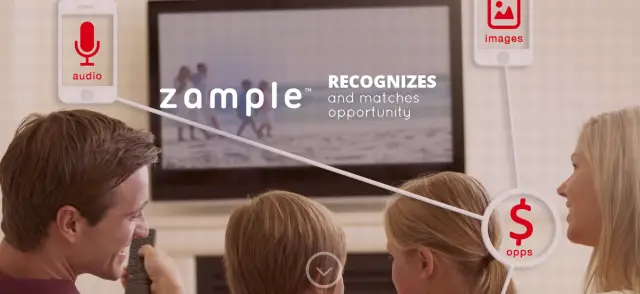
Zample is like Shazam for advertising and second screen experiences
We’re sure you’ve used apps like Shazam and SoundHound to identify unknown music that might be playing in a club or on the radio. What if we told you that a hot new advertising startup was looking to use those same concepts to shake up the world of mobile marketing and app development? Sunnyvale-based Zample wants to do just that with a unique new platform that will help developers and users alike.
To put it simply, an app that uses Zample would literally listen to what’s going on around — be it a movie or TV show you’re watching — to help identify your interests. The technology itself isn’t user-facing, but rather a tool for developers who could use the more useful analytics it provides to help serve up better ads and in-app experiences.
Need a visual? Imagine a developer uses Zample and the analytics show 80% of their userbase happens to watch Oprah. The developer could use that information to serve up ads that encourage people to subscribe to Oprah’s book club on Amazon or to download the official Oprah app.
Beyond advertising, Zample could also soon enable rich “second screen” experiences, giving users a breadth of information on their tablet and smartphone about whatever they’re watching. The second screen concept is not unlike what Yahoo was doing with IntoNow before they decided to shut it down.
As exciting as all that sounds, though, it’s worth noting that Zample is only looking to launch the analytics component of their SDK at thi tmie. So what’s Zample’s secret recipe for something like this? Let’s break it down for you.
How Zample works
Zample is a cloud-powered platform that has information on many different consumer products, brands, television shows and movies. The SDK allows developers’ apps to periodically “listen to” the user’s surroundings, and will use what it hears to deliver more information about their users’ interests. It does this by using a system similar to Shazam’s, which can identify songs, shows and movies based on audio alone, and gives the user more information about whatever they’re listening to or watching.
“The intended benefit for developers is to not have to think about what contextual offers or other relevant content will show up and what to do with it, just let Zample manage that,” said a Zample spokesperson.
For instance, the app might recognize that the user is currently watching an episode of Dexter, and will let the developer know that someone in their userbase enjoys Dexter. The developer can then use whatever data they gathered to deliver ads and other meaningful content, or they can let Zample do that heavy lifting for them.
Going back to the Dexter example, if a developer notices that a large amount of their users enjoy watching Dexter they could deliver ads that will urge you to buy a set of DVDs from Showtime, or check out more clips online. They could also show you more information about the episode you’re watching, characters from the show and other tidbits that may interest you.
Zample is hooked up with live broadcasting information from over 100 different networks, spanning hundreds of thousands of hours of movies, TV shows and even all the ads shown in between. This wide range of sources ensures developers will have no shortage of relevant content, ads and information to deliver to the end user.
Quelling common concerns
One of our first questions upon hearing about Zample was how the company would look to protect user privacy. After all, it isn’t wholly comforting to know that an app could randomly enable your microphone at any given point for the sake of analytics and monetization. We have concerns in a couple of different areas:
- Privacy concerns regarding data collection
- Battery life issues from constant use of the microphone
Thankfully, Zample had no problem addressing either one. In the realm of privacy, we’re told that information is never personally identifiable, so you can probably rest easy knowing your information isn’t being sold off to marketing sharks.
And then there’s the issue of battery life, though Zample says we should have nothing to worry about. Their SDK doesn’t draw on battery any more than any other analytics or advertising solution.
The microphone in the device is only “listening” for a short amount of time whenever Zample does its periodic check, so any impact on battery life is negligible and incidental. While we don’t have a clear picture of Zample’s SDK or a full set of policies just yet, Zample assures us that their offering shouldn’t scare potential privacy zealots away.
The future of Zample
We’re quickly reminded that this is only the beginning for Zample. Alongside listening for movies, TV shows and advertisements, Zample is also exploring a couple of other options for expanding their SDK. Namely, they’ll want to add music to their repertoire, and might also experiment with bringing live radio broadcasts into the mix.
Zample also has plans to introduce an image component to their SDK, allowing developers to gather information on their users’ interests based on the images they come across within their app.
The rollout will be quite ambitious for this new startup, but they’ll be tackling it with a three-pronged launch rollout that’ll allow them to get their ducks in a row and ultimately deliver the best product possible:
- Analytics. The first stage is to equip developers with the base analytics gathering tool that will allow them to see what their userbase is interested in. Developers can do whatever they see fit with this information, including using it to effectively target advertising with an alternate advertising platform.
- Advertising. Secondly, they’ll be integrating their ad delivery component which can automatically serve up appropriate and relevant ads without much work on the developer’s part.
- Second Screen. Finally, they will look to give developers the tools they need to create unique features such as an app that delivers information about whatever they’re watching.
This will all be fueled by the $2 million private injection Zample got to help with this ambitious launch, but it won’t take money alone for this to work. They’ll need actual developers getting their hands dirty and helping them perfect the platform to make sure it’s polished as well as can be ahead of the full-scale rollout.
One such developer is Tok.TV, whose baseball app enables friends to talk and chat with each other while the ball game is going on. It sounds like the perfect marriage for an app like this, as Tok Baseball could recognize which exact baseball game each friend is currently watching and automatically setup a chat between them (while also delivering real-time and relevant stats, player information and more like it already does).
The potential for Zample is huge, and we can’t wait to see the unique offerings that’ll eventually spawn as a result of its existence. Interested in finding out more? They’re currently accepting inquiries over at their website, so get over there and take a look if this is something you think would be perfect for your own app.

